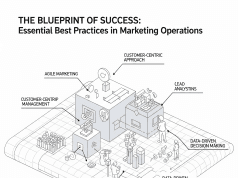In the rapidly evolving digital landscape, marketing technology (MarTech) has emerged as a critical component for organizations seeking to enhance customer engagement, streamline processes, and drive revenue. However, without a cohesive MarTech stack, companies may struggle to leverage these tools effectively, leading to fragmented strategies and missed opportunities. Here, we explore key strategies for creating an integrated MarTech stack that maximizes efficiency and performance.
Understanding the MarTech Stack
A MarTech stack is a collection of technology tools and platforms that marketers use to manage and analyze their marketing efforts. This can include customer relationship management (CRM) systems, email marketing platforms, analytics tools, social media management suites, and more. However, the effectiveness of a MarTech stack hinges upon how well these components work together.
The Importance of Integration
Integration is crucial for several reasons:
- Data Cohesion: A unified stack allows for seamless data flow among different platforms, ensuring that all departments have access to the same information.
- Enhanced Customer Experience: Integrated technologies enable marketers to deliver personalized communications and experiences across various channels, thereby increasing customer satisfaction and loyalty.
- Operational Efficiency: By minimizing manual data entry and reducing silos, organizations can allocate resources more effectively and streamline workflows.
- Better Decision-Making: With consolidated data, marketers can make more informed decisions based on comprehensive insights rather than fragmented data points.
Strategies for Creating an Integrated MarTech Stack
1. Define Objectives and Requirements
Start by identifying business goals and marketing objectives. What do you want to achieve with your MarTech stack? Whether it’s improving lead generation, enhancing customer engagement, or increasing sales, having clear objectives will enable you to choose the right tools and platforms.
2. Evaluate Existing Tools
Assess the tools currently used within your organization. Identify which platforms are essential and which can be phased out or replaced. Consider their compatibility with potential new tools to ensure that they can integrate seamlessly.
3. Prioritize Open APIs and Integrations
When selecting new technologies, prioritize platforms that offer open APIs (Application Programming Interfaces) and built-in integrations. This flexibility makes it easier to connect diverse tools and systems, creating a more cohesive environment.
4. Foster Collaboration Among Teams
Encourage collaboration between marketing, sales, IT, and customer service teams. Each department’s input is invaluable in ensuring that the selected tools meet the organization’s varied needs. Regular cross-departmental meetings can help keep all teams aligned as the MarTech stack evolves.
5. Implement a Centralized Data Hub
Consider using a centralized platform for data management, such as a customer data platform (CDP). A CDP aggregates information from multiple sources, ensuring that your data is up to date and readily available for analysis and reporting.
6. Opt for Solutions with Built-In Analytics
Select MarTech solutions that offer robust analytics capabilities. These tools should allow you to measure performance across different channels, providing insights into what works and what doesn’t. This data is invaluable for refining strategies and optimizing campaigns.
7. Train and Support Users
Even the best MarTech stack can falter if users don’t know how to utilize it effectively. Invest in training programs and support to help teams understand how to use the tools at their disposal. Enhanced user adoption translates to improved outcomes.
8. Regularly Review and Adapt
The digital marketing landscape is continuously evolving. Regularly review your MarTech stack’s performance and make adjustments as needed. Stay informed about emerging technologies and trends in the industry to ensure your stack remains optimized.
Conclusion
Building a cohesive MarTech stack involves careful planning, integration, and ongoing management. By following these strategies, organizations can create a robust and interconnected environment that enhances marketing effectiveness and customer engagement. In an age where agility and responsiveness are key, an integrated MarTech stack empowers businesses to not only meet the demands of today’s consumers but also thrive in an increasingly competitive landscape. Embrace the philosophy of “Integrate and Conquer,” and watch your marketing efforts reach new heights.









